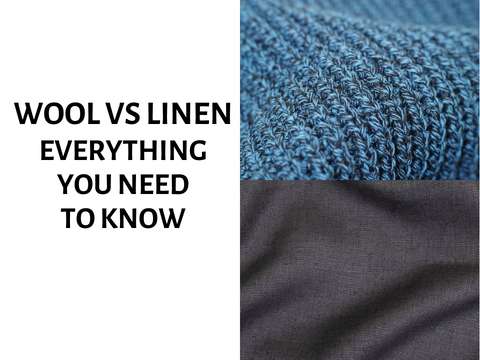Wool vs Linen – Everything You Need to Know
What’s the difference between wool and linen? If you’re like most people, you probably have no idea. Most people assume that wool and linen are similar, but they are quite different. In this article, we will explore the differences between wool and linen and see which one is better. We will also discuss the benefits and differences of each fabric. So, without further ado, let’s get started!
Wool VS Linen – Overview

To understand how wool and linen work, we have to know what exactly wool and linen are. Wool is a type of animal fiber that comes from sheep, alpaca, Cashmere goat, camel, and vicuna. It is often used to make clothing, blankets, and other textile products. Linen, on the other hand, is a plant-based fiber that comes from the flax plant. It is often used to make sheets, bath towels, and other household items.
What is Wool
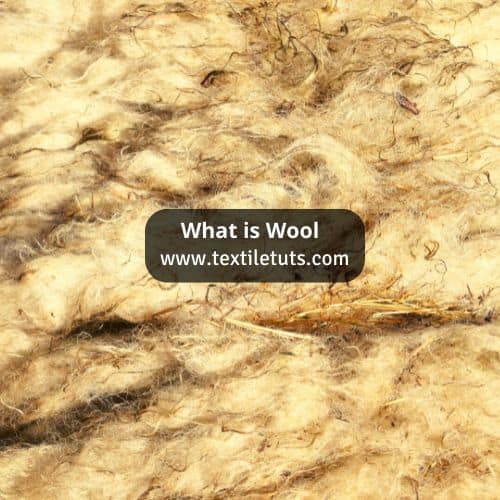
Wool is a natural fiber that comes from animals, most commonly sheep. It is one of the oldest natural fabrics in existence, and it has been used throughout history for clothing, upholstery, and other textiles. Wool fibers are strong and durable, making them ideal for high-quality garments and fabrics.
Wool Fibers
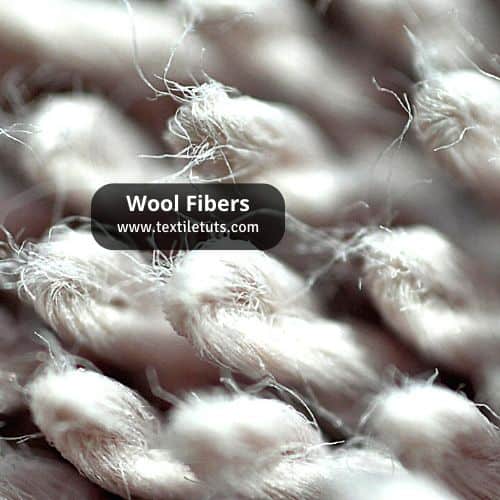
Wool is derived from the sheep’s coat, which consists of two types of fibers: the longer guard hairs and the shorter, softer undercoat fibers. To harvest the wool, the sheep must first be shorn using special electric clippers. The shorn wool is then cleaned and processed to remove any dirt or impurities. The wool is then spun into yarn, which can be used to make a variety of different fabrics.
Types of Different Wools
- Tweed
- Wool Felt
- Gabardine
- Wool Jersey
- Boucle
- Wool Batting
- Loden
- Broadcloth
- Herringbone wool
- Chenille
- Flannel
- Tartan
Characteristics of Wool
Wool fibers have many properties that make them ideal for use in clothing and other textile products. They are strong and durable yet flexible and resilient. Wool fibers are also naturally good at insulating against both heat and cold, making them a popular choice for winter garments. In addition, wool is a soft fabric that is comfortable to wear.
What is Linen
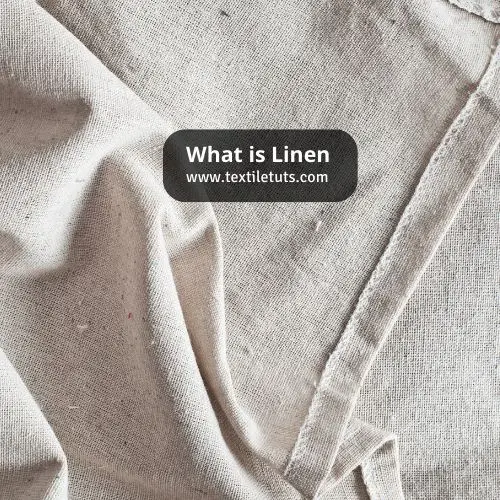
Linen is a textile made from the fibers of the flax plant, also known as vegetable fibers, which are native to Europe and North Africa. It’s a great fiber to use for textiles because it has a unique texture and drapes strongly that you can’t find in other fibers. Linen fiber is absorbent and quickly dries, making it a popular choice for summer clothing. Linen fabric is made from the long, strong fibers that grow inside the stalks of the flax plant.
Linen Fibers
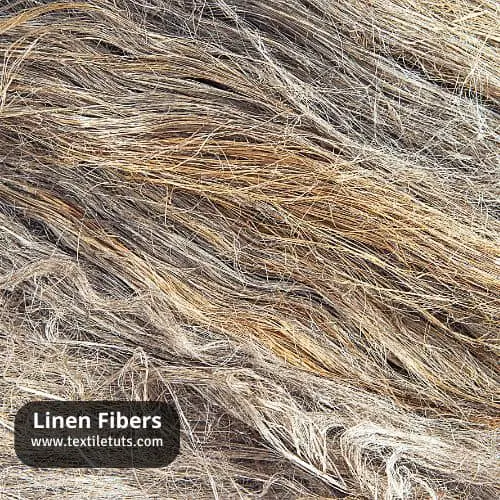
To make linen fiber, the flax plants are harvested, and the stalks are soaked in water. The fibers are then separated from the woody parts of the plant and spun into yarn. The yarn is then woven or knit into linen fabric. Linen garments are often considered to be upscale and luxurious fabrics, as linen is more expensive than other fabrics such as cotton fibers or wool fibers. Again, compared to cotton, wool is so expensive.
Interestingly, merino wool costs a lot more than normal wool, and it can be comparable with regular linen fabrics.
Types of Different Linen
- Damask linen
- Plain weave linen
- Linen Jersey
- Homespun linen
- Linen batiste
- Loose weave linen
- Closely-woven linen
- Linsey-woolsey
Characteristics of Linen
Linen fabrics are strong and durable, making them ideal for a variety of products, such as clothing, sheets, and towels. Linen is also highly absorbent, meaning it can easily wick away sweat and moisture. In addition to its absorbency, linen is also known for its breathability. Overall, linen is a versatile and practical fabric that can be used for a variety of purposes.
Wool Vs Linen – The Benefits
Benefits of Wool
When it comes to fabrics, wool is praised for its ability to keep people warm in cold weather. Wool can absorb moisture, stretch, and return to its original shape. Wool fibers are also able to trap body heat, which is why they are often used in cold-weather clothing. In addition to being warm, wool is also a natural material that is biodegradable and recyclable.
As a result, it’s considered to be a more sustainable option than synthetic fabrics. When it comes to fabric choices, wool is a great option for those who are looking for something both stylish and practical. Wool is an extremely durable fabric, which makes it ideal for outdoor activities such as hiking and camping.
Benefits of Linen
It’s a popular choice for summer clothing because it’s very lightweight and breathable. The linen is also absorbent, which makes it ideal for hot weather. The absorbency of linen helps to keep the body cool by drawing moisture away from the skin. In addition to being absorbent, linen is also a natural material that is biodegradable and recyclable.
Wool Vs Linen – Key Features
Key Features Wool
- Wool is a heavier material, making it ideal for winter clothes.
- Wool fabric has a higher thread count and is usually softer than linen.
- Wool is also a natural material that is biodegradable and recyclable.
- Wool fibers are also able to trap body heat.
- Wool is considered to be a more sustainable option than synthetic fabrics
- Wool is more absorbent than linen and will hold onto moisture more.
Key Features Linen
- Linen is a much more lightweight fabric than wool, making it a better choice for summer clothing.
- Linen is more durable than wool and does not shrink or pill.
- Linen is less likely to wrinkle than wool.
- Linen is made from flax fibers, which makes it environmentally more friendly than wool with better sustainability.
- Linen is free from skin issues like allergies.
Wool Vs Linen – Which Should You Choose?
If you’re like me, you’ve probably spent hours agonizing over what fabric to choose for your next project. Do you want something soft and cuddly or something crisp and cool? Wool or linen? In the end, it all comes down to personal preference. But if you’re still undecided, here are a few points to consider from the consumer perspective.
Making a Coat or Sweater
When it comes to making a sweater, wool is the better choice. It’s soft, warm, and durable, while linen is stiff and tends to wrinkle easily. Wool also has natural water-repelling properties, which help keep you warm and dry in cold weather. Wool is also very durable, making it ideal for heavy-use items such as coats and sweaters. In addition, wool has its own advantages, offering sleek lines and a professional appearance that is tough to match.
Making a Shirt or Dress
Linen is the better choice for making a shirt or dress. It’s lightweight and breathable, making it perfect for warm weather. It also has a natural tendency to resist wrinkles, which makes it ideal for travel. And because linen is made from flax fibers, it’s environmentally friendly and sustainable. If you’re searching for a summer shirt or dress, opt for linen.
Making a Quilt
Both wool and linen make great quilts. Linen is lightweight and breathable, while wool is warm and long-lasting. If you can’t decide between the two, why not use them both? A wool-linen quilt will be warm in winter and cool in summer.
Making a Hat
Wool is the better choice for making a hat. It’s warm and durable, while linen is lightweight and tends to wrinkle easily. Wool also has natural water-repelling properties, which help keep you dry in wet weather. If you want a warm winter hat, wool is the way to go.
Making Socks and Gloves
Both wool and linen make great socks and gloves. Wool is warm and durable, while linen is lightweight and breathable. If you can’t decide between the two, why not use both? A wool-linen sock will be warm in winter and cool in summer.
Making Sheets and Bedding
Linen is the better choice for making sheets and bedding. This fabric is perfect for warm weather. It is lightweight and breathable. Plus, it doesn’t wrinkle easily, so it’s great for travel. And since linen is made from flax fibers, it is environmentally friendly and sustainable. So, if you’re looking for summery sheets or bedding, go with linen cause the properties of linen sheets can easily keep up with you.
Washing Wool Vs Washing Linen
Many people are familiar with the basic idea of how to care for different types of fabric: wool should be washed in warm water, while linen can be washed in hot. However, there is more to consider when it comes to taking care of these two materials.
Washing Wool
- Mix together 1/4 cup Woolite or other detergent with enough warm water to fill up the sink.
- Submerge your clothes and swish them around for about 10 minutes before rinsing out all excess soap residue in two separate sessions – don’t rub any fabric against each other during this time!
- Place items flat on towel-dried slowly away from direct sunlight, so they do not stretch while drying.
- First, perming everything inside out, then soak according for as long as necessary, no more than 30 minutes. Afterward, rinse in cool water also inside out and lay it flat on a clean white cotton towel to dry.
Note: You should never wring or stretch wool garments as it will damage the shape and size of the item!
Washing Linen
Linen is much easier to take care of in comparison to wool.
- Soak the soiled item in cold water for about 15 minutes before washing on a delicate cycle with a mild detergent.
- You can also add 1/2 cup of white vinegar to the rinse water, which will help remove any lingering odors.
- Do not put it in the dryer as it will shrink
- Let it air dry on a clothesline or drying rack.
- If you’re looking to remove wrinkles, simply hang up your linen while it’s still damp, and the wrinkles should fall out on their own.
How Do I Decide Between Linen & Wool?
Linen is often seen as the cooler fabric because it is made from natural fibers and has a loose particular weave. This combination makes it more breathable than other fabrics, which means it does a better job of regulating body temperature. Additionally, linen absorbs moisture, so it can help keep you feeling dry even in hot and humid weather.
Wool, on the other hand, is not as breathable as linen. However, since it’s a great insulator, so it can help keep you warm in cold weather. Wool is also moisture-resistant, so it can be a good choice if you tend to sweat a lot.
Sheep’s wool is often used in business attire because it provides a sharp appearance without looking overly formal. Wool can also be worn for longer periods of time without showing signs of wear. In general, linen has a relaxed and more loose appearance, while wool is more tailored and structured. When deciding which fabric to choose for your clothing, it is important to keep these differences in mind.
Frequently Asked Questions
What fabric is better than linen?
Linen is notoriously difficult to clean, and it’s often necessary to dry clean clothes made from this fabric. Cotton/Hemp is a good alternative, as it’s much easier to care for. Consider the climate where you’ll be wearing the clothes made from the fabric. Linen is a great choice for warm weather, but in cooler climates, something like wool or cashmere will be more comfortable and stylish.
Is linen hot to sleep on?
The general properties of linen make it suitable for warm air and hot weather. It is a light fabric, and it breathes well, allowing airflow to circulate around your body. Additionally, linen products are often pre-washed, so they are less likely to shrink or fade in the heat.
Will a wool blanket pill more than linen?
Wool and linen are both popular fabrics used to make blankets. Wool blankets tend to be more durable and provide more warmth than linen blankets, but these blankets are more prone to pilling.
This is due to the shorter fibers that make up the wool fabric. Since linen has longer fibers, it will pill less than wool. However, it is important to note that pilling will still occur with linen blankets, but to a lesser degree than a wool blanket.
Does linen shrink after wash?
When purchasing linen products, it is important to keep in mind that they may shrink after the first wash. Once these fibers are wet, they contract and become shorter. As a result, linen clothing may feel tighter after being washed for the first time. However, linen will return to its original shape and size once it dries. For this reason, it is important to select a size that allows for shrinkage when making clothing out of linen fabric.
Is Linen a Better Choice Than Wool for Keeping Your Feet Dry?
When it comes to keeping your feet dry, wool socks are often considered a better choice than linen. Wool socks keep feet dry by wicking away moisture and providing insulation. Linen, on the other hand, absorbs moisture and may not offer the same level of protection against wetness.
Who Wins?
Well, it depends on what you’re looking for. Linen is a cool fiber that has a natural sheen and resists wrinkle and keeps you cool in hot weather. It’s perfect for items that need to be durable and look good over time – like tablecloths, napkins, and bed sheets. Wool, on the other hand, is a warm fiber that can resist flame and dirt. It’s great for projects where you need insulation – like sweaters, hats, scarves, and blankets.
So, which one do you prefer? The luxurious feel of wool or the crisp elegance of linen? Who wins in the race of Wool vs linen? Which one should you choose for your next project? Let us know via comments.

